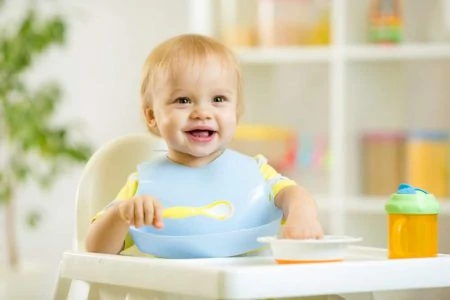Are you tired of the daily wrestling match to get your toddler into their high chair? You aren’t alone.
Most parents wonder exactly when they should stop using a high chair. While there isn’t a hard-and-fast rule, the switch usually happens between 18 months and 3 years old. Ultimately, it depends on your child’s physical development, behavior, and your own comfort level.
Here are the clear signs it’s time to ditch the high chair and our favorite tips for a smooth, tear-free transition.
Key Takeaways
- Watch for readiness signs: If your child is escaping, physically outgrowing the seat, or demanding to sit with “big kids,” it is time to switch.
- Safety first: An unsecured toddler on a regular chair is a fall risk; ensure they can follow basic safety rules before ditching straps entirely.
- Use a bridge: Transitioning to a booster seat is often safer and easier than moving straight to a standard dining chair.
- Prioritize posture: Ensure your child still has foot support (like a footrest or box) to help them feel stable and stay seated longer.
When to Switch From High Chair to Booster Seat?
You might feel like it’s time to retire the high chair, but you don’t want to create extra stress or safety hazards by swapping too soon.
So, how do you know if your toddler is truly ready for the next step?
Here are five signs to look out for:
1. The High Chair Is Creating Chaos
If your child screams, arches their back, or goes boneless whenever you try to put them in the seat, it might be time to move on.
Mealtime should be about socialization and nutrition, not a battle of wills. As toddlers become more independent, the confinement of a high chair can feel restrictive, leading to tantrums that disrupt the whole family.
2. They Can Follow Basic Rules
Moving to a booster or regular chair requires a new level of maturity. Following high chair safety rules is non-negotiable, especially if you plan to bypass a booster seat.
Before making the switch, ensure your child understands that chairs are for sitting, not standing, rocking, or climbing. They also need to understand that plates, bowls, and utensils must stay on the table, not be thrown on the floor.
3. You’ve Got a Little Houdini
Has your child figured out how to unbuckle that five-point harness? Can they wiggle their legs out and stand up on the seat?
Once your child becomes an escape artist, the high chair transforms from a safety device into a fall hazard. If you can’t keep them strapped in securely, it is safer to move them to a seat closer to the ground or a booster with a different buckling mechanism.
4. They Want To Be Like You
Toddlers love to imitate. Have you noticed your child copying everything you do?
When a child reaches this developmental phase, they notice that Mom, Dad, and older siblings aren’t strapped into plastic buckets. They might also see older kids at daycare sitting at regular tables. Naturally, they want to graduate to a “big kid” chair to feel included.
5. They Are Physically Too Big
Sometimes the sign is purely physical. If your child’s knees are banging against the tray, or if they look squished and uncomfortable, they have likely outgrown the seat.
If you have to wrestle the tray onto the chair because their tummy is in the way, or if the harness straps are maxed out, it is definitely time to upgrade their seating arrangement.
Transitioning Out of the High Chair
You have identified the signs, and your child is ready to graduate. But how do you handle the logistics without losing your mind?
Every child is different, but a strategic approach helps.
Here are our top tips for transitioning away from the high chair:
1. Make It Gradual
You don’t have to go “cold turkey” unless safety is an immediate issue.
Start by having your child sit in a booster or regular chair for snacks, but keep using the high chair for major meals. This lets them practice sitting still for short bursts. Once they prove they can stay seated and follow rules during snack time, you can graduate them to lunch and dinner.
2. Use a Booster Seat
Strapped boosters are the perfect middle ground. They bring your child up to table height so they can eat comfortably, but they still offer containment.
When choosing a booster seat, look for one that straps securely to your dining chair and has a belt for your child. Avoid restaurant-style boosters for home use, as they lack stability.
If you have a space saver high chair, you can likely convert it into a booster simply by removing the backrest and tray.
3. Don’t Forget Foot Support
One reason toddlers squirm in regular chairs is that their legs dangle. This cuts off circulation and makes them feel unstable (imagine sitting on a barstool without a footrest for an hour).
If you move them to a regular chair or booster, try to rig up a footrest. You can place a sturdy box, a step stool, or a stack of heavy books under their feet. When their feet are planted, they are more likely to sit still and eat longer.
4. Create a “Kid Zone”
If your child refuses a booster but is too small for the main table, a child-sized table and chair set is a fantastic alternative.
This allows them to sit with their feet flat on the floor, giving them full autonomy. You can serve them their meal at their special table nearby while the family eats. This is also a great way to host “dinner parties” for their stuffed animals or friends.
5. Make Mealtime Engaging
Turn off the TV and banish phones from the table. When mealtime is a social event, your child is less likely to get bored and wander off.
Engage them in conversation, ask about their day, and model good table manners. If they are entertained by the family dynamic, they won’t feel the need to escape their new, less-restrictive chair.
FAQs
Bye Bye, High Chair
Deciding when to stop using a high chair is a big milestone for your little eater. If the chair is causing chaos, creating safety risks for an escape artist, or simply too small for your growing toddler, it is time to make a change.
Whether you switch to a booster seat or a dedicated toddler table, remember to keep it fun and safe. With a little patience and a lot of encouragement, your child will be dining like a “big kid” in no time.









